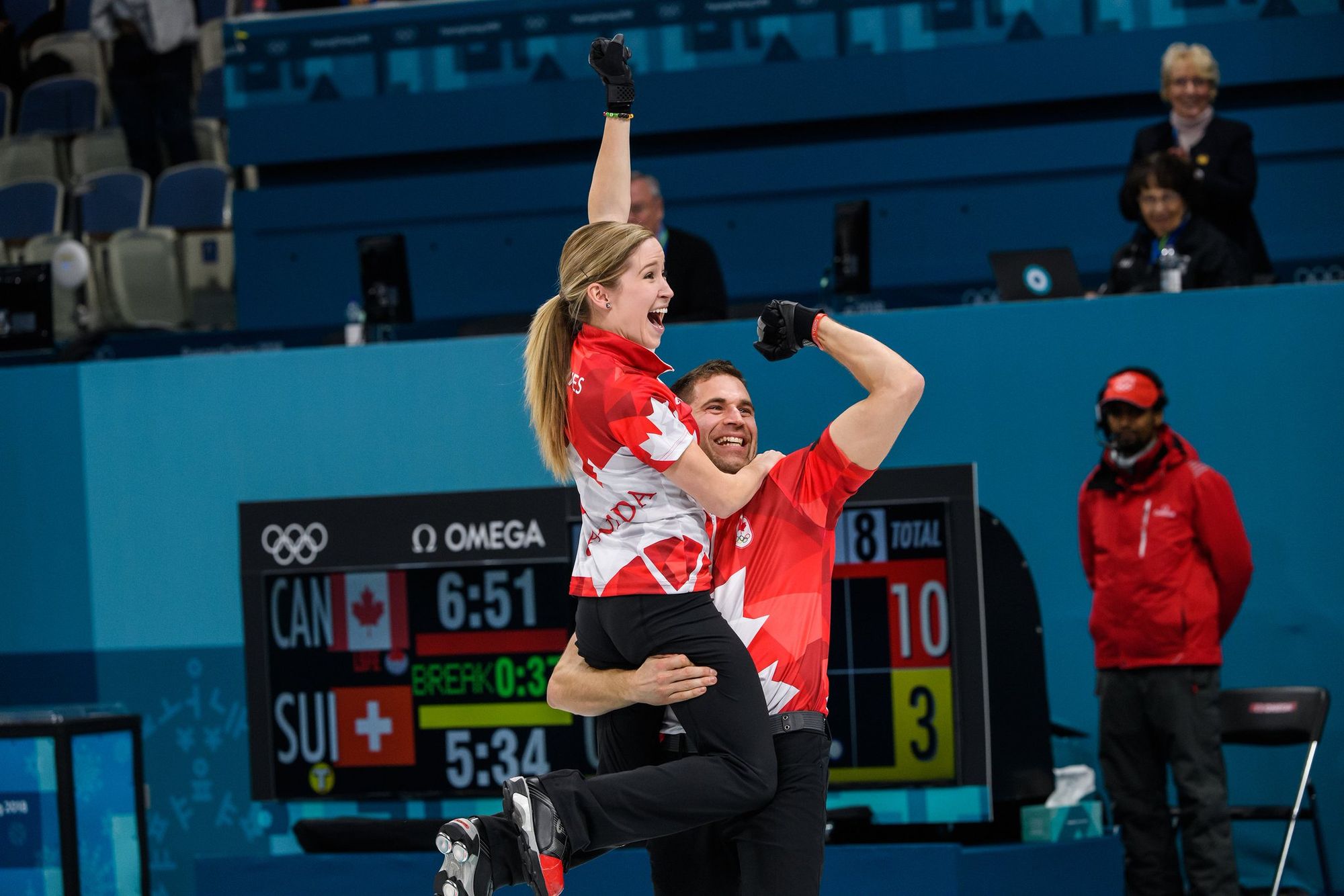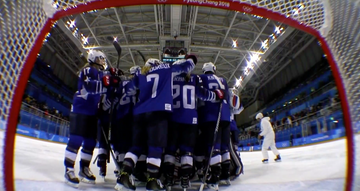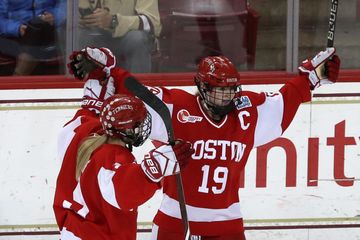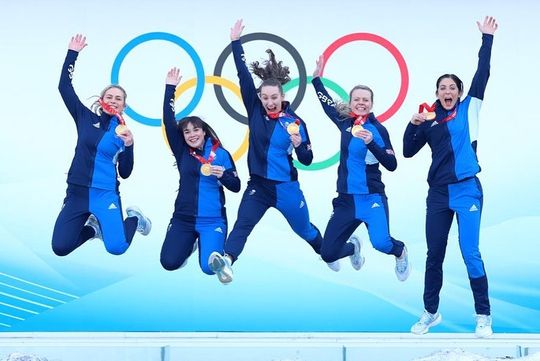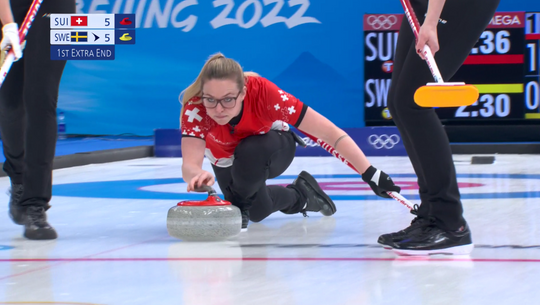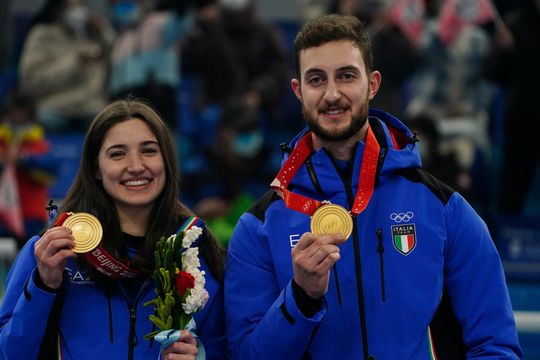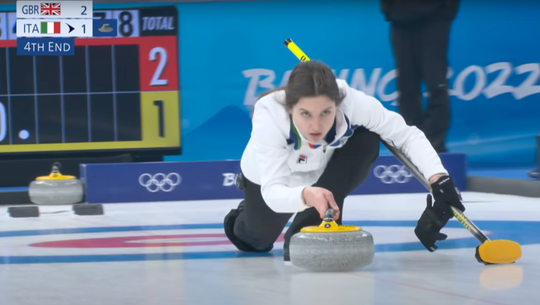The mixed-doubles curling playoff round provided ample tension and excitement.
Canada took on Norway in the first semi-final. John Morris started strong against Norway, impressing with a surgical double to clear the rings of Norwegian stones in the first end. Kristin Skaslien's error with her final shot allowed Kaitlyn Lawes a chance at four, but her draw was heavy and the Canadians only scored two in the opening end. By their standards, the first half of the game was difficult for the Canadian pair, with Lawes' uncharacteristic heavy draw weight to blame. In the fourth end, Lawes needed to make another shot under duress, but instead of throwing the original call, a hit and stick, she opted for a draw. Perhaps overcompensating for her earlier heavier draws, Lawes' final stone came up short, stopping short of the four foot.
Entering the half leading by just one, Morris was emphatic in his belief that Kaitlyn would turn things around with an interview with CBC's Colleen Jones. The Canadian commentary team of Mike Harris, Joan McCusker, and Bruce Rainnie made much of Morris' speech and his excellence as a teammate, crediting his speech with a predicted turn around in Lawes' game. While one of Morris' strengths is his positivity as a teammate, surely Lawes deserves most of the credit for her play in the second half of the semi-final.
And turn things around she did. In the fifth, Morris threw a freeze that went deep with his last stone, and Lawes needed to make a freeze against the Norwegian shot stone. Lawes made a great shot, putting the pressure on Skaslien to deliver with hammer. She couldn't -- she wrecked on a guard, and it was a steal of two for Canada and changed the course of the game. Down 5-2 in the sixth end, Norway used its power play, a tactic the Canadians have defended remarkably well to that point. Morris missed a double with his last shot of the end but Lawes picked him up by hitting and sticking and keeping Norway to just two points.
Lawes continued to turn things around in the seventh by playing an inturn freeze for three. It was a great shot with an equally great sweep and gave Canada a commanding lead going into the eighth end. Her final shots in ends five, six, and seven were essential to the 8-4 Canadian victory. Lawes finished the semi-final having curled at 58%. While well-bellow her typical excellence, it was a considerable improvement over the 43% she curled through four. For his part, Morris was excellent, curling at 82% while his counterpart Magnus Nedregotten curled at just 66%. Despite some notable misses, Skaslien had a good game numbers-wise, curling at 77%.
The Olympic athletes from Russia played Switzerland in the second semi final. OAR's Alexsandr Krushelnitckii, who had a disappointing round robin, picked the right draw to have his game of the tournament. He curled at 86% or 23% higher than his round robin average. Switzerland scored two with hammer in the first and OAR matched with a pair of its own in the second. The draw was evenly matched through, OAR was 76% for the game and Switzerland was 78%. The difference was Switzerland was able to steal in ends four and eight to secure a 7-5 victory.
Norway's second half slide continued in the bronze medal game against OAR. Anastasia Bryzgalova and Krushelnitckii started fast, scoring two with hammer in the first end, then stealing in the second. Down 3-0, Norway clawed two back in the third, but then promptly surrendered two in the fourth to enter the break down by three. Nedregotten and Skaslien scored two with the hammer in 5 to get within one. They held the OAR pair to one in six, but could stop Krushelnitckii and Bryzgalova from stealing in seven and eight for the 8-4 win and bronze medal.
No doubt Norwegian errors contributed to the score line. Skaslien curled at 64% and Nedregotten curled at 65%, both below their round robin averages. But the Russian athletes play should not be ignored. Krushelnitckii continued his strong play from the semi-final game, curling at 79% while impressing on draws (83%). Bryzgalova saved her best game for a medal contest. One of the best players of the tournament, Bryzgalova curled at 83% in the bronze medal match. Critically, she curled at 83% on nine takeouts, best Nedregotten who threw the middle three stones for Norway, who managed to curl at just 71% on seven takeouts.
Canada's gold medal match performance was the opposite of its stressful semi-final draw. Morris and Lawes got out to the early lead, securing two with the hammer in the opening end. Switzerland's Martin Rios set up a score of two for the Swiss with a nice double on his final throw of the end.
The third end was the turning point of the gold medal game. Rios missed the open hit to take out three Canadian stones wide, setting the stage for Lawes to throw for four. In the hack, Lawes was forced to call a technical timeout because the handle of her stone was loose. Once tightened, she was able to refocus and throw one of the greatest shots of the mixed doubles tournament. But she also did an excellent job sweeping her own throw, a perfect tap back for four.
Desperate and sensing the gold was slipping away, Switzerland called their power play in the fourth end. Morris and Lawes did what they had done all Olympics, successfully defending the power play, once again holding an opponent to one. Canada got two with hammer in five.
Canada stole two more in six, and then it was handshakes. While Rios struggled in the final, his teammate Jenny Perret had a great game, curling 75%. But it was not enough when faced with the excellence of Lawes and Morris.
The Canadian pair fully deserved the gold. After dropping the opener to Norway, Morris and Lawes went 8-0 to close out the tournament. Canada had a goal differential of +37. China was the only other team with a positive differential and they were only +3. Lawes and Morris were the best players of the tournament, both integral to the win.
While the mixed doubles tournament wrapped up a successful introduction to the Olympics, generating significant spectator interest and even some new curling fans, not everyone was swayed that mixed doubles curling deserves to be at the Olympics. All sports are arbitrary. Their rules are created and agreed upon. Some sports, like curling, are centuries old, which provide an artificial air of legitimacy that newer sports (or newer incarnations) like mixed doubles lack. But that does not invalidate mixed curling. While the sport made its debut at the Olympics, it has had a world championship for a decade and has been on the curling tour for almost 20 years.
It is not the relative newness of mixed curling that rankles critics, but men and women competing together as equals, equally responsible for their team's athletic success. Surely many will point out Lawes couldn't have won without Morris. Fewer will acknowledge that Morris couldn't have won without Lawes either.
The IOC and other sporting bodies should encourage mixed competition and gender diverse competition. Mixed curling isn't fake and it isn't made up (at least not any more than any sport). It's a way forward.
(Photo credit: Team Canada/Twitter)
